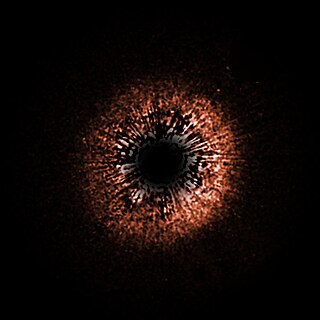
HD 107146 is a star in the constellation Coma Berenices that is located about 90 light-years (28 pc) from Earth. The apparent magnitude of 7.028 makes this star too faint to be seen with the unaided eye.
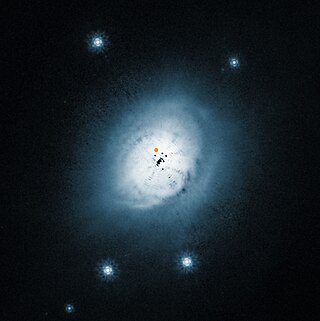
HD 100546, also known as KR Muscae, is a pre-main sequence star of spectral type B8 to A0 located 353 light-years from Earth in the southern constellation of Musca. The star is surrounded by a circumstellar disk from a distance of 0.2 to 4 AU, and again from 13 AU out to a few hundred AU, with evidence for a protoplanet forming at a distance of around 47 AU.
HD 97048 or CU Chamaeleontis is a Herbig Ae/Be star 603 ly away in the constellation Chamaeleon. It is a variable star embedded in a dust cloud containing a stellar nursery, and is itself surrounded by a dust disk.
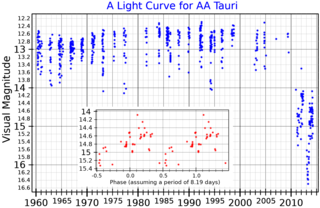
AA Tauri is a young variable star in the equatorial constellation of Taurus, located in the Taurus-Auriga star-forming region. It is too faint to view with the naked eye, having an apparent visual magnitude that varies from 12.2 down to 16.1. The star is located approximately 439 light-years away from the Sun based on parallax, and is drifting further away with a radial velocity of +17 km/s.
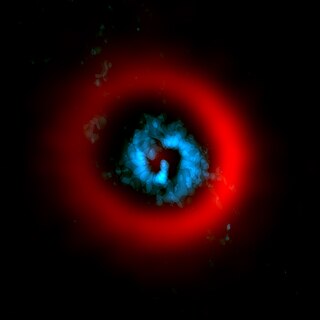
AB Aurigae is a young Herbig Ae star in the Auriga constellation. It is located at a distance of approximately 531 light years from the Sun based on stellar parallax. This pre-main-sequence star has a stellar classification of A0Ve, matching an A-type main-sequence star with emission lines in the spectrum. It has 2.4 times the mass of the Sun and is radiating 38 times the Sun's luminosity from its photosphere at an effective temperature of 9,772 K. The radio emission from the system suggests the presence of a thermal jet originating from the star with a velocity of 300 km s−1. This is causing an estimated mass loss of 1.7×10−8 M☉ yr−1.

HD 142527 is a binary star system in the constellation of Lupus. The primary star belongs to the Herbig Ae/Be star class, while the companion, discovered in 2012, is a red dwarf star or accreting protoplanet with a projected separation of less than 0.1″. The system is notable for its circumbinary protoplanetary disk and its discovery has helped refine models of planet formation. The orbit of companion is strongly inclined to the circumbinary protoplanetary disk.
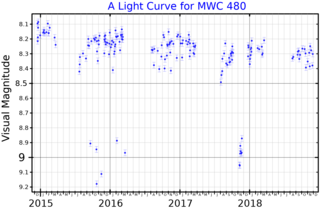
MWC 480 is a single star, about 500 light-years away in the constellation of Auriga. It is located in the Taurus-Auriga Star-Forming Region. The name refers to the Mount Wilson Catalog of B and A stars with bright hydrogen lines in their spectra. With an apparent magnitude of 7.62, it is too faint to be seen with the naked eye.

HD 259431 is a young stellar object in the constellation of Monoceros.
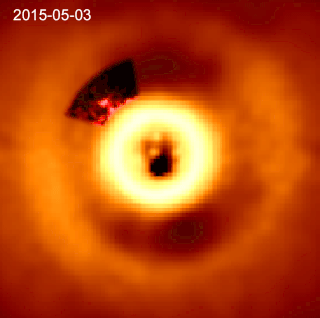
HD 169142 is a single Herbig Ae/Be star. Its surface temperature is 7650±150 K. HD 169142 is depleted of heavy elements compared to the Sun, with a metallicity Fe/H index of −0.375±0.125, but is much younger at an age of 7.5±4.5 million years. The star is rotating slowly and has relatively low stellar activity for a Herbig Ae/Be star.

PDS 70 is a very young T Tauri star in the constellation Centaurus. Located 370 light-years from Earth, it has a mass of 0.76 M☉ and is approximately 5.4 million years old. The star has a protoplanetary disk containing two nascent exoplanets, named PDS 70b and PDS 70c, which have been directly imaged by the European Southern Observatory's Very Large Telescope. PDS 70b was the first confirmed protoplanet to be directly imaged.

AK Scorpii is a Herbig Ae/Be star and spectroscopic binary star about 459 light-years distant in the constellation Scorpius. The star belongs to the nearby Upper Centaurus–Lupus star-forming region and the star is actively accreting material. The binary is surrounded by a circumbinary disk that was imaged with VLT/SPHERE in scattered light and with ALMA.
ROXs 12 is a binary system of pre-main-sequence stars. It belongs to the Rho Ophiuchi cloud complex. The surface temperature of the primary star is 3900±100 K. ROXs 12 is much younger than the Sun with an age of 7.6+4.1
−2.5 million years.

RW Aurigae is a young binary system in the constellation of Auriga about 530 light years away, belonging to the Taurus-Auriga association of the Taurus Molecular Cloud. RW Aurigae B was discovered in 1944.

HD 53367 is a triple star system in the constellation of Monoceros. The primary star was identified as a variable Herbig Ae/Be star in 1989. Its companion, spectroscopically discovered in 2006, is a pre-main-sequence star star with an average separation of 1.7 AU. The star system is embedded in the extended nebula IC 2177.

HD 150193 is a binary star system in the constellation of Ophiuchus. The primary star was identified as a Herbig Ae/Be star with a strong solar wind, losing approximately a tenth of solar mass per million years. It does host a very small debris disk, likely due to disk truncation by the nearby stellar companion. The disk is inclined 38±9° to the plane of sky. It appears to be highly evolved and asymmetric, with indications of flattening and grains growth.

GK Tauri is a young T Tauri-type pre-main sequence star in the constellation of Taurus about 421 light years away, belonging to the Taurus Molecular Cloud.
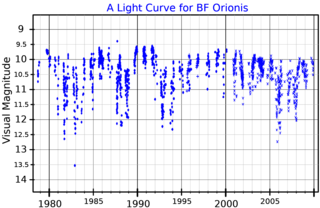
BF Orionis is a young Herbig Ae/Be star in the constellation of Orion about 1250 light years away, within the Orion Nebula. It is the most massive star of the small birth cluster of four stars.
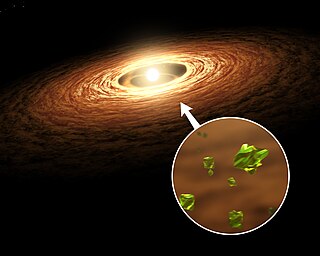
EX Lupi is a young, single T-Tauri star in the southern constellation of Lupus. An irregular variable, it is the prototype of young, low-mass eruptive stars named EXors, with EX Lupi being this object's variable star designation. At its minimal activity level, EX Lupi resembles a classical T-Tauri star of the M0 dwarf type. The low latitude of this star, at a declination of −40°, makes it difficult for northern observers to view. Based on parallax measurements, it is located at a distance of about 505 light years from the Sun. The star lies next to a gap in the Lupus cloud complex, a star forming region.
HD 100453 is a binary star system which lies in the constellation Centaurus about 350 light years away from the Sun and is a member of the open cluster Scorpius–Centaurus association.

CQ Tauri is a young variable star in the equatorial constellation of Taurus. It is too faint to be visible to the naked eye with an apparent visual magnitude that ranges from 8.7 to 12.25. The distance to this star is approximately 487 light years based on parallax measurements, and it is drifting further away with a radial velocity of ~23 km/s. It appears to be part of the T-association Tau 4. CQ Tauri lies close enough to the ecliptic to undergo lunar occultations.

















